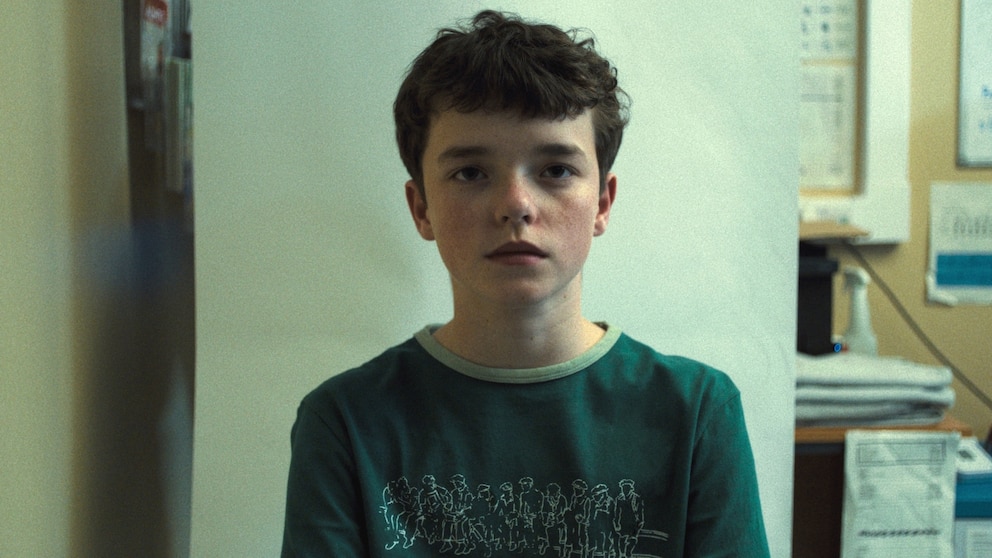In a move that’s got parents talking and sparking heated debates, Netflix has just dropped its newest series, ‘Adolescence.’ This gripping drama is not your typical coming-of-age story, and its unflinching portrayal of the complexities and challenges faced by teenagers has left audiences reeling. The show’s raw, unapologetic take on the intricacies of adolescence is forcing viewers to confront the harsh realities of growing up in the modern age. As parents struggle to keep up with the ever-changing landscape of social media, identity politics, and societal expectations, ‘Adolescence’ is offering a searing commentary on the pressures and pitfalls of modern youth. But what exactly is it about this show that’s got parents so fired up? Let’s take a closer look.

The Show’s Exploration of Bullying, Social Media, and Mental Health
One of the most compelling aspects of ‘Adolescence’ is its unflinching portrayal of the pressures faced by teenagers today. The series delves into the pervasive issue of bullying, a problem that has long been a concern for parents and educators alike. The show illustrates how bullying can escalate from seemingly innocuous teasing to serious consequences, often exacerbated by the influence of social media.
According to a study by the Cyberbullying Research Center, 37% of teens have experienced some form of bullying online. This figure underscores the gravity of the issue and highlights the need for open conversations about cyberbullying. ‘Adolescence’ addresses this by showing the real-life impact of online harassment and the ripple effects it has on young minds. The series doesn’t shy away from the harsh realities, making it a stark reminder for parents and guardians to stay vigilant.
The show also explores the complex relationship between teenagers and social media. In today’s digital age, social media platforms have become integral to teenage life, offering both opportunities for connection and pitfalls for mental health. ‘Adolescence’ illustrates how the constant pressure to present a perfect image online can lead to anxiety and depression. A report by the Royal Society for Public Health found that social media use is linked to increased rates of anxiety, depression, and poor sleep quality among young people.
Graham, who portrays Eddie Miller, the father of the accused teen, discusses the challenges parents face in this digital era. “When I was young, if there was something going on that parents wanted to protect their children from, you’d be sent to your room,” Graham told The Independent. “But today, even within the context of that home, when lads and girls go to their bedrooms, they have the world at their fingertips.” This shift in how information is accessed and consumed is a significant theme in the series, highlighting the need for parents to understand the digital landscape their children navigate.
The series also tackles the broader issue of mental health, a topic that has gained increasing attention in recent years. According to the Centers for Disease Control and Prevention, in 2019, nearly 1 in 5 adolescents in the U.S. experienced a major depressive episode. ‘Adolescence’ does not shy away from the complexities of mental health, showing how societal pressures, bullying, and the lack of open communication can lead to severe mental health issues.
One of the most poignant scenes in the series involves Jamie’s struggle with his mental health. The character’s internal monologue and interactions with his peers and family members paint a vivid picture of the emotional turmoil that many teenagers face. This portrayal is not just a narrative device; it serves as a call to action for parents and educators to foster open dialogues about mental health.
The show’s exploration of bullying, social media, and mental health is not just a dramatic plot point but a reflection of the real-world challenges faced by teenagers. By addressing these issues head-on, ‘Adolescence’ encourages viewers to engage in meaningful conversations about these topics. The series is a testament to the power of storytelling in raising awareness and sparking important discussions.
The Impact of Social Media on Teen Mental Health
Social media’s impact on teen mental health is a multifaceted issue that ‘Adolescence’ explores with sensitivity and depth. The show delves into how the constant exposure to curated images and the pressure to maintain a perfect online persona can lead to feelings of inadequacy and anxiety.
Researchers from the University of Oxford found that social media use is correlated with poorer sleep quality, lower self-esteem, and higher levels of anxiety and depression among teenagers. The series reflects these findings through Jamie’s character, who struggles with the pressure to meet societal expectations and the fear of being judged online.
In an interview with Gizmoposts24, Dr. Amanda Lenhart, a senior researcher at the Pew Research Center, commented on the series’ portrayal of social media’s impact. “The show does an excellent job of illustrating the psychological toll that constant comparison and the fear of missing out can take on young minds,” she said. “It’s a stark reminder that while social media can be a tool for connection, it can also be a source of significant stress and anxiety.”
Another critical aspect of the series is its depiction of the role of social media in bullying. The show highlights how online platforms can amplify bullying, turning isolated incidents into viral shaming. This is a sobering reminder of the need for better regulation and awareness campaigns to protect young users.
Gizmoposts24 spoke with Emily Vachon, a cyberbullying expert and author of “Stop Bullying: A Guide for Parents and Teachers,” who praised the series for its realistic portrayal. “The show doesn’t sugarcoat the harsh realities of cyberbullying,” Vachon said. “It shows how easily words can escalate and the lifelong impact they can have. This is a powerful message for both teens and adults.”
Moreover, the series underscores the importance of parental involvement in monitoring and guiding teens’ online activities. It emphasizes the need for open communication and setting boundaries to mitigate the negative effects of social media. Parents are encouraged to have regular conversations about online safety and mental well-being, ensuring that their children feel supported and understood.
Mental Health Awareness and Support
Mental health is a central theme in ‘Adolescence,’ with the series offering a raw and honest portrayal of the challenges faced by teenagers. The show does not shy away from the complexities of mental health issues, making it a valuable resource for parents and educators.
According to the National Institute of Mental Health, approximately 20% of children and adolescents in the U.S. experience a severe mental disorder at some point in their lives. ‘Adolescence’ brings this statistic to life through Jamie’s character, who grapples with feelings of isolation, anxiety, and despair. The series highlights the importance of early intervention and support for teens struggling with mental health issues.
Dr. Lisa Damour, a psychologist and author of “Untangled: Guiding Teenage Girls Through the Seven Transitions into Adulthood,” spoke with Gizmoposts24 about the series’ portrayal of mental health. “The show does an excellent job of showing the internal struggles of a teenager,” she said. “It’s a reminder that mental health is not just an adult issue but something that affects young people deeply.”
The series also emphasizes the role of parental support in addressing mental health issues. Jamie’s interactions with his father, Eddie, highlight the impact of family dynamics on a teenager’s well-being. The show encourages parents to be vigilant and supportive, creating a safe space for their children to express their feelings and seek help when needed.
‘Adolescence’ is not just a drama; it’s a call to action for parents, educators, and policymakers to address the mental health challenges faced by teenagers. By bringing these issues to the forefront, the series encourages open conversations and fosters a supportive environment for young people.
The Impact of Bullying on Teenagers
Netflix’s latest series, “Adolescence,” delves into the raw and often brutal realities faced by teenagers today. One of the central themes is bullying and its profound impact on the mental health and well-being of adolescents. According to a study by the Cyberbullying Research Center, approximately 34% of students have experienced bullying at school, while 15% reported being victims of cyberbullying. This percentage increases when considering the cumulative effects over several years. “Adolescence” portrays Jamie Miller’s life as he grapples with the aftermath of a tragedy, which is intertwined with the pressures and bullying he faces. The show’s creators, Stephen Graham and Jack Thorne, use Jamie’s story to highlight the severity and consequences of bullying, urging viewers to consider the potential long-term effects on youth.
The series also addresses the societal and cultural factors that contribute to bullying. Through Jamie’s interactions with peers and his experiences, “Adolescence” exposes the underlying reasons behind bullying behaviors, such as a lack of empathy and understanding, peer pressure, and the normalization of aggressive behavior. The show’s portrayal is a stark reminder that bullying is not just a schoolyard issue but a serious problem affecting the mental and emotional growth of adolescents.
The Role of Social Media in Shaping Teenagers’ Lives
Another significant theme explored in “Adolescence” is the role of social media in shaping teenagers’ lives. The series underscores how social media platforms can both empower and endanger adolescents. A report by Pew Research Center reveals that 95% of teens have access to a smartphone, and 45% are online almost constantly. This level of connectivity exposes teens to both positive and negative online experiences. The show highlights how Jamie and his peers use social media, not just for communication, but also as a source of entertainment, self-expression, and identity formation. However, it also demonstrates the darker side of social media, including cyberbullying, online harassment, and the spread of misinformation.
The portrayal of social media in the series is a reflection of real-world issues. Experts suggest that the constant exposure to idealized lifestyles and body images on social media can lead to anxiety, depression, and a distorted sense of reality for teenagers. “Adolescence” uses Jamie’s narrative to illustrate these points, showing how the pressures of online life can exacerbate feelings of inadequacy and isolation. The show’s representation of social media’s impact provides a critical lens through which to view the broader implications of online behavior on adolescent mental health.
Conclusion
As we conclude our discussion on Netflix’s new series ‘Adolescence’ and its impact on parents, it’s clear that the show has sparked a necessary conversation about the complexities of growing up in today’s digital age. The article highlights the series’ realistic portrayal of teenage struggles, from social media anxiety to mental health concerns, resonating with many who have experienced similar challenges. Moreover, the show’s exploration of parental relationships and the often-blurred lines between guidance and overprotection has sparked debate among parents, many of whom are now reevaluating their own parenting strategies.
The significance of this topic cannot be overstated, as the series sheds light on the pressing issues affecting today’s youth. By tackling these sensitive subjects head-on, ‘Adolescence’ serves as a reminder that parents must be willing to confront their own biases and limitations in order to provide their children with the support they need to thrive. As we move forward, it will be essential for parents, educators, and policymakers to continue this conversation, working together to create a safer, more supportive environment for young people to grow and flourish.
Ultimately, the impact of ‘Adolescence’ will be felt long after the final episode ends. By sparking a conversation that will continue to evolve and grow, the series has the potential to inspire meaningful change and create a brighter future for generations to come. As we reflect on the complexities of adolescence and the crucial role parents play in shaping the next generation, one thing is clear: the conversations sparked by ‘Adolescence’ will be a catalyst for lasting change, one that will forever alter the way we raise, support, and understand our children.






Add Comment